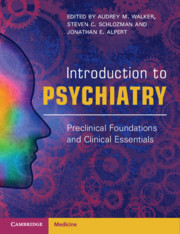Book contents
- Introduction to Psychiatry
- Introduction to Psychiatry
- Copyright page
- Contents
- Contributors
- 1 Introduction
- 2 Clinical Neuroscience
- 3 Introduction to the Patient Interview
- 4 Mood Disorders
- 5 Schizophrenia Spectrum and Other Psychotic Disorders
- 6 Anxiety Disorders
- 7 Obsessive-Compulsive and Related Disorders
- 8 Disorders Related to Stress and Trauma
- 9 Substance Use Disorders
- 10 Personality Disorders
- 11 Neurocognitive Disorders
- 12 Feeding and Eating Disorders
- 13 Child Psychiatry and Neurodevelopmental Disorders
- 14 Sleep Disorders
- 15 Psychopharmacology and Neurotherapeutics
- 16 Psychosocial Interventions
- 17 Psychiatric Evaluation in the Medical Setting
- 18 Psychiatry of Gender and Sexuality
- 19 Health Policy and Population Health in Behavioral Health Care in the United States
- 20 Global Health and Mental Health Care Delivery in Low-Resource Settings
- Index
- References
15 - Psychopharmacology and Neurotherapeutics
Published online by Cambridge University Press: 22 July 2021
- Introduction to Psychiatry
- Introduction to Psychiatry
- Copyright page
- Contents
- Contributors
- 1 Introduction
- 2 Clinical Neuroscience
- 3 Introduction to the Patient Interview
- 4 Mood Disorders
- 5 Schizophrenia Spectrum and Other Psychotic Disorders
- 6 Anxiety Disorders
- 7 Obsessive-Compulsive and Related Disorders
- 8 Disorders Related to Stress and Trauma
- 9 Substance Use Disorders
- 10 Personality Disorders
- 11 Neurocognitive Disorders
- 12 Feeding and Eating Disorders
- 13 Child Psychiatry and Neurodevelopmental Disorders
- 14 Sleep Disorders
- 15 Psychopharmacology and Neurotherapeutics
- 16 Psychosocial Interventions
- 17 Psychiatric Evaluation in the Medical Setting
- 18 Psychiatry of Gender and Sexuality
- 19 Health Policy and Population Health in Behavioral Health Care in the United States
- 20 Global Health and Mental Health Care Delivery in Low-Resource Settings
- Index
- References
Summary
Antidepressants are among the most widely prescribed medicines in the United States, particularly in psychiatry and primary care medicine. According to the US Centers for Disease Control, approximately 13 percent of the US population aged twelve years or older were prescribed an antidepressant in a recent year. Although antidepressants may be overprescribed in some patient populations and underprescribed in others, the overall high rate of antidepressant use is almost certainly related to the high prevalence of the conditions for which antidepressants are clinically indicated and approved by the US Food and Drug Administration (FDA). These conditions include major depressive disorder, generalized anxiety disorder, panic disorder, social anxiety disorder, obsessive-compulsive disorder, and posttraumatic stress disorder. In addition, certain antidepressants are used in the treatment of pain syndromes (e.g., fibromyalgia, migraine or neuropathic pain), bulimia nervosa, binge eating disorder, premenstrual symptoms, somatic symptom disorders, irritable bowel syndrome, insomnia, and body dysmorphic disorder, as well as to help individuals quit smoking.
- Type
- Chapter
- Information
- Introduction to PsychiatryPreclinical Foundations and Clinical Essentials, pp. 342 - 388Publisher: Cambridge University PressPrint publication year: 2021

